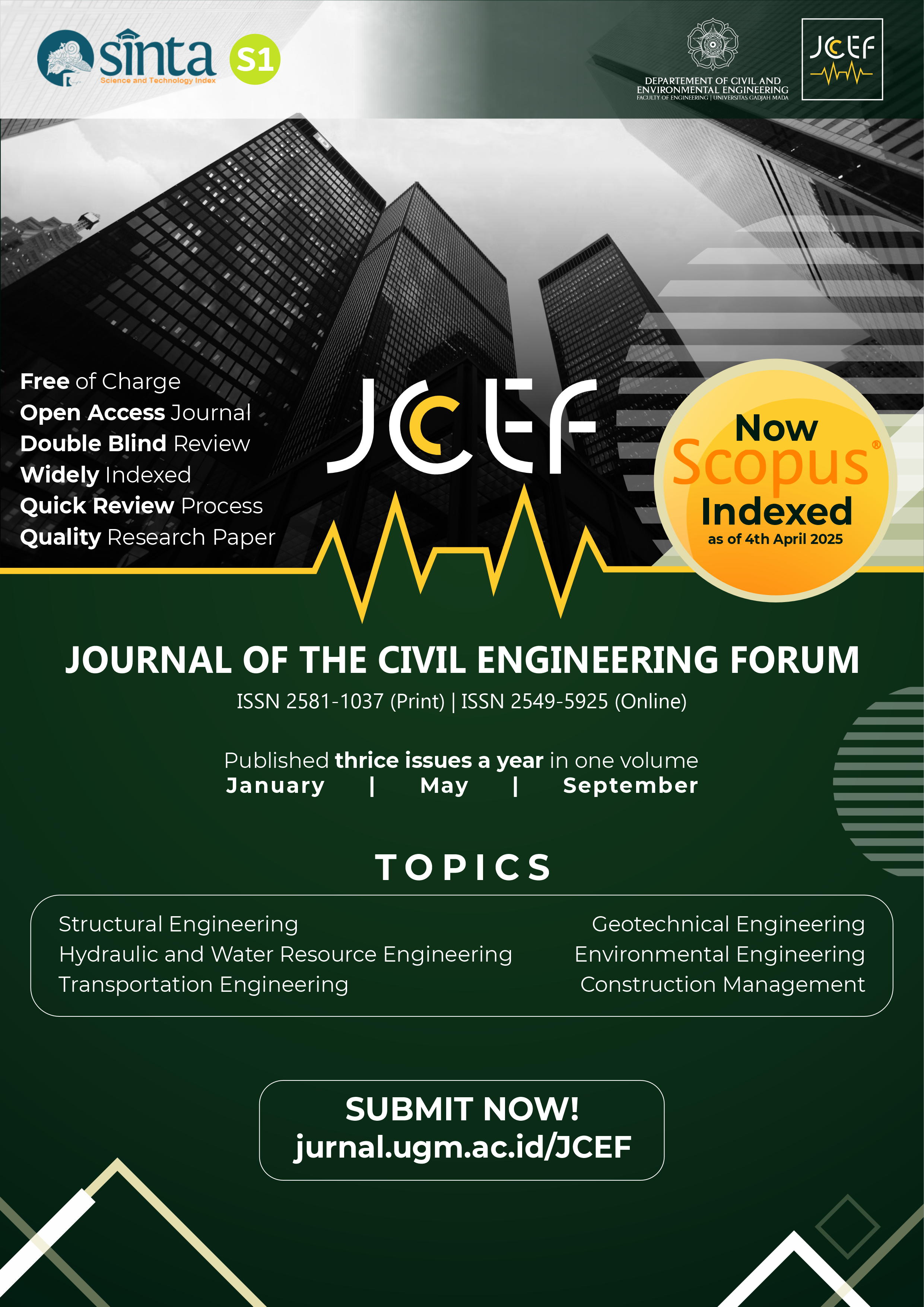Chemical Anchor Pullout Force Modeling with Variation of Anchor Embedment Length in Concrete and Concrete Strength
Abstract
The embedment length influences the adhesion between the cast iron material and the concrete. The concrete's compression strength also contributes to an increase in bond strength. Therefore, this research aims to determine the maximum pullout force on each variation of the anchor and the optimal embedment length. A gauge is modeled as a rod-type with a diameter of 16 mm, and the embedment lengths used are 5D, 10D, and 15D, while the compressive strengths include fc’ 20, 30, 40, 50, and 60 MPa. Furthermore, a finite element-based application was utilized with the ANSYS Workbench student version. The result showed that the concrete with strengths of 20, 30, 40, 50, and 60 MPa has maximum pullout forces of 27.011, 53.536, 68.657, 68.970, and 84.407 kN, respectively at an embedment length of 15D. It was observed that the failure pattern obtained starts from the defect in the concrete cone and ends with the breakage of reinforcement or steel failure at each variation of concrete strength. A combination of two non-parametric techniques was used in this research, which includes Kruskal Wallis and U-Mann Whitney test. The first technique revealed that the chi-square value for strengths 20, 40, 50, and 60 MPa is 9.486, while that of 30 MPa is 9.881. The second test employed showed a significance value below 0.05. In conclusion, the embedment length affected the value of pullout force, and 15D was the optimum embedment length for each variation of concrete strength. The enhancement in tensile strength increases with the strength of the concrete.
References
Al-fouadi, WKA, and Mohammed, AH (2018) "Experimental and analytical study on the behavior of pullout failure of reinforcing bar embedded in concrete blocks," Structural Concrete, 20(July), pp. 171–184.
Al-Zuhairi, A. and Sahi, W. (2013) "Numerical prediction of bond-slip behavior in simple pullout concrete specimens," University of Baghdad Engineering Journal, 19(1), pp. 1–12.
Assegaf, A., Mukid, MA, and Hoyyi, A. (2019) "Analysis of Bank Health Using Local Mean K-Nearest Neighbor and Multi Local Means K-Harmonic Nearest Neighbor," Gaussian Journal, 8(3), pp. 343–355.
Breitenbucher, R. et al. (2014) "Experimental, analytical and numerical analysis of the pullout behavior of steel fibers considering different fiber types, inclinations, and concrete strengths," Structural Concrete, 15(2), pp. 126–135.
Canonsburg, TD (2013a) ANSYS Mechanical APDL Material Reference. Canonsburg, PA 15317.
Canonsburg, TD (2013b) ANSYS Meshing User's Guide. Canonsburg, PA.
Cattaneo, S. and Muciaccia, G. (2016) "Adhesive anchors in high-performance concrete," Materials and Structures/Materiaux et Constructions, 49(7), pp. 2689–2700.
Effendi, MK (2020) "Non-Linear Finite Element Analysis of Flexural Reinforced Concrete Beam using Embedded Reinforcement Modeling," Journal of the Civil Engineering Forum, 6(3), p. 271.
Hu, Z., Shah, YI and Yao, P. (2021) "Experimental and numerical study on interface bond strength and anchorage performance of steel bars within prefabricated concrete," Materials, 14(13).
Jamco, juan charles and Balami, abdul malik (2020) "Kruskal-Wallis analysis to determine student learning concentration based on the field of interest of the Unpatti Fmipa Statistics Study Software," Journal of Mathematics, Statistics, and Applied Research, 1(1), pp. 39–44.
Khalaf, RD et al. (2020) "Analytical Study on Effect of Bar Size on Pull-out force for Reinforcing Bar Embedded in Concrete Blocks," IOP Conference Series: Materials Science and Engineering, 928(2).
Prayogo, GM, Rosyidah, A. and Ketut Sucita, I. (2018) "Modeling of the Reinforcement Minimum Spacing of Precast Concrete Using Grouting," Proceedings - 2018 International Conference on Applied Science and Technology, iCAST 2018, pp. 674–679.
Riani, E. (2018) The Effect of Anchoring Depth Variations on Bond Strength of Deformed Steel Reinforcements in Normal Concrete, Lightweight Concrete and High Quality Concrete. Mataram University.
Sibagariang, Y. et al. (2020) Experimental study of anchor pull out forces with variations in distance, Juitech. Quality University.
Sriwidadi, T. (2011) "Using the Mann-Whitney Test on the Analysis of the Effect of Salesperson Training on New Product Sales," Binus Business Review, 2(2), p. 751.
Topcu, IB et al. (2016) "Prediction of Pullout Performance of Chemical Anchors Embedded into Concrete," ICENS, 24-28, pp. 440–457.
Upadhyaya, P. and Kumar, S. (2015) "Pullout capacity of adhesive anchors: An analytical solution," International Journal of Adhesion and Adhesives, 60, pp. 54–62.
Yilmaz, S., zen, MA and Yardim, Y. (2013) "Tensile behavior of post-installed chemical anchors embedded to low strength concrete," Construction and Building Materials, 47, pp. 861–866. https://doi:10.1016/j.conbuildmat.2013.05.032.
Copyright (c) 2022 The Author(s)

This work is licensed under a Creative Commons Attribution-ShareAlike 4.0 International License.
Copyright is granted to authors for the purpose of providing protection for articles written to describe experiments and their results. JCEF will protect and defend the work and reputation of the author and are also willing to address any allegations of violation, plagiarism, fraud, etc. against articles written and published by JCEF. JCEF is published under the terms of the Creative Commons Attribution-ShareAlike 4.0 International License (CC BY-SA 4.0). The author holds the copyright and assigns the journal rights to the first publication (online and print) of the work simultaneously.







